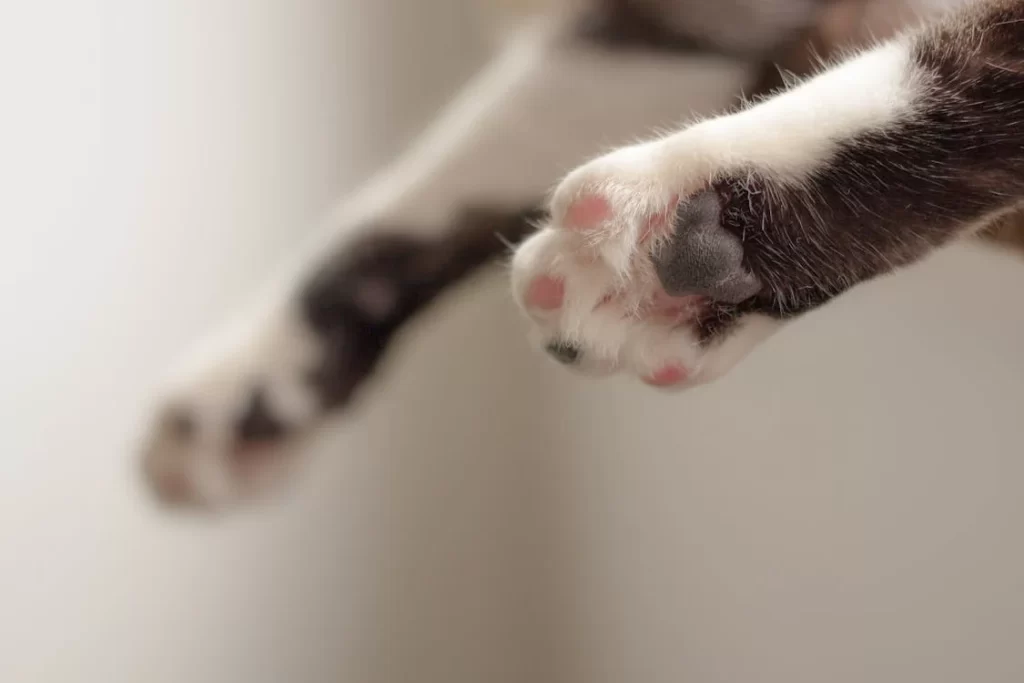
Two black cats live in our household. They both used to have light pink paw pads but their pads changed to black over time. I did some research to figure out why my cats’ paw pads have changed and if the change is a normal finding.
Cats’ paw pads can change their pigment from pink to grey or black as the cat matures. This process is usually normal, as long as there are no other changes, such as skin sloughing, inflammation, swelling, or behavioral changes that suggest pain.
What Colors Are Normal for Paw Pads?
Paw pads can vary in color from light pink to grey and black. Usually, cats with light fur have pink or greyish paw pads, while dark grey and black kitties have grey or black paw pads.
Many black cats have pink or light paw pads at a young age but the color darkens as the cat ages.
The pad can change color completely or the cat might have patchy paw pads. Both findings are normal but the change is usually gradual. It takes months to years.
The Composition and Function of Paw Pads
The technical term for paw pads and toe beans is digital pads are made of thick pigmented skin tissue, collagen, and fat.
The functions of the pads include the following:
- shock absorption
- added stability when moving around
- marking territory using the scent glands on the pads
- temperature regulation by sweating
Why Did My Cat’s Paw Pads Turn Black?
As mentioned above, a cat’s digital pads can change as the cat ages.
Dark pads usually stay the same color. It is quite common for light pink pads to darken, in the case of dark cats in particular. The pigment changes to match the color of the cat.
Orange, beige, white, and light grey cats usually have pink or pinkish digital pads their entire lives, but theirs can also become dark. It is not uncommon.
Usually, the change is not concerning, provided that it is gradual and no other findings point to a problem.
As your kitty matures, his or her paw pads could gradually turn black partially or completely. Some black cats have black paw pads pretty much since birth.
There is no cause for concern if an otherwise healthy cat experiences a gradual change in the color of his or her paw pads. There are, of course, other causes of paw pad color changes, some of them are not much of an issue on their own but should be evaluated by a veterinarian.
Other reasons for discoloration of paw pads.
Several other conditions can cause changes in a cat’s paw pads:
- Hyperpigmentation is common in older cats. It causes dark patches over the animal’s entire body, including the paw’s digital beans.
- Animals can also be affected by vitiligo, which causes progressive loss of pigment in the body.
- Autoimmune disorders can cause a change in the color of the pads but the pads are more likely to become lighter than darker. The change is rarely isolated: the paw pads might look dry, inflamed, and even peeling. There can also be other changes in the cat’s health status.
- Dehydration and malnutrition can cause discoloration of the paw pads. However, these changes are accompanied by other concerning findings, including weight loss and fatigue.
- Anemia causes pallor of the mucous membranes of the mouth and pale paw pads.
- Infection can discolor the paw pads and turn them dark or light. Along with this change, the paw pas could also look swollen, inflamed, and painful and might have areas of sloughing off.
Finally, environmental conditions can affect the color of the paw pads temporarily. For example, hot pavement can cause burns in extreme cases, and dryness and redness in milder cases. Dark discoloration can follow the initial response to heat. Other injuries can cause similar discoloration and changes in the texture.
Recent Posts
Long-haired cats are especially likely to have very long whiskers and eyebrows, but they are never too long for the cat. Avoid trimming your cat's whiskers or eyebrows. They play a role in several...
Many dogs are prone to chasing and even nipping cats and other smaller animals. It is a problem when your dog meets a cat outside. It is an even bigger problem if your dog chases and herds your...

